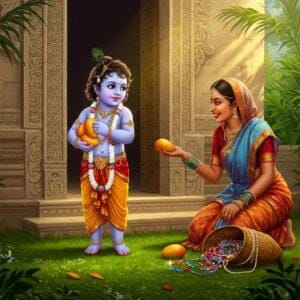
Little Krishna Kindness to the Fruit Seller
Click below link if you want to buy this Image
Among the many enchanting stories from the life of Lord Krishna, one particularly heart-touching episode is that of the fruit seller and young Krishna. This story is a profound illustration of the power of love, devotion, and divine grace—captured vividly in the image above.
In the picture, we see little Krishna, with His skin the color of a monsoon cloud and adorned with simple jewelry and a peacock feather in His hair, holding several fruits in His tiny arms. Opposite Him is a humble fruit seller, an old woman with a warm smile, offering Him more fruit while her basket overflows—not with fruits anymore, but with priceless jewels.
The Simple Offering of the Heart
According to the legend from the Bhagavata Purana, this moment occurred when young Krishna was living in Gokul. One day, a poor fruit seller came to the village, calling out to sell her wares. Krishna, hearing her voice, wanted to trade. Since He didn’t have money, He picked up a few handfuls of grains and ran to her. But by the time He reached her, most of the grains had slipped through His little fingers.
Despite the small, practically empty offering, the woman was so charmed by the beauty and innocence of Krishna that she gave Him all the fruits she had. She didn’t expect anything in return. Her gesture was pure and full of motherly love.
When she returned to her home, she found her basket filled not with fruits, but with dazzling jewels and gems. It was Krishna’s divine way of rewarding her love and selfless devotion.
Symbolism and Spiritual Insight
This story is not just a sweet tale from mythology; it carries deep spiritual meaning. The fruit seller represents every devotee. The fruits symbolize material offerings—our efforts, time, and service. The grains Krishna carried represent the small and imperfect things we offer to God with love. Though they may be materially insignificant, when offered with a pure heart, they are more valuable than the richest treasures.
Krishna’s divine response shows that God does not measure our offerings by quantity or worth but by the sincerity behind them. In return, He gives us far more than we can imagine—inner peace, spiritual joy, and ultimately, liberation.
The Eternal Charm of Krishna’s Childhood
Little Krishna’s childhood stories are among the most loved in Hindu tradition. Whether it’s stealing butter, playing with the gopis, or performing miracles, each tale carries layers of meaning—teaching us values of love, surrender, and the joy of divine play (leela).
Artists through the ages have depicted this particular scene countless times, inspired by its emotional and spiritual resonance. In the painting shown, the vibrant expressions, the traditional Indian setting, and the detail in the fruit and jewels draw us into a divine moment frozen in time.
A Message for Devotees
This story reminds us that in our relationship with the Divine, sincerity of heart matters more than material wealth or elaborate rituals. Like the fruit seller, when we offer what little we have with love and devotion, the Divine responds with grace that transforms our lives in unimaginable ways.
Whether you are a spiritual seeker or someone who finds joy in cultural stories, this episode of Krishna and the fruit seller reminds us that true giving comes from the heart—and when it is received by divine hands, it returns a thousandfold in beauty and blessing.

